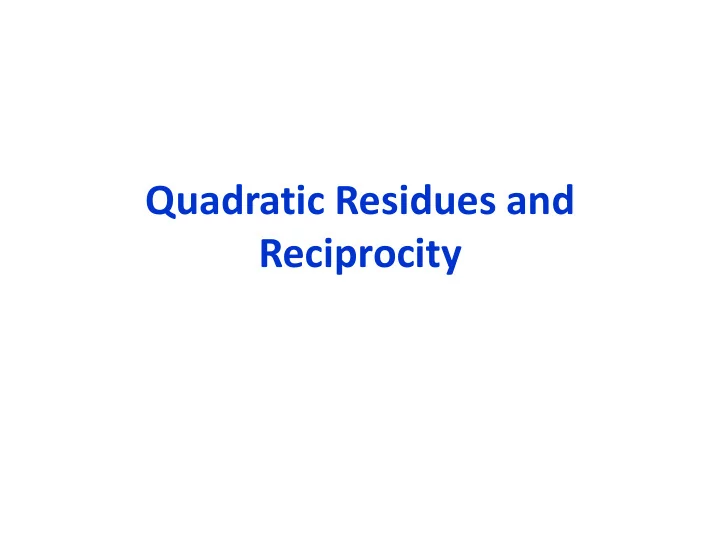

Quadratic Residues and Reciprocity
• Is 3 congruent to the square of some number modulo 7 ? • 0 2 ≡ 0 (mod 7), 1 2 ≡ 1 (mod 7), 2 2 ≡ 4 (mod 7), 3 2 ≡ 2 (mod 7), 4 2 ≡ 2 (mod 7), 5 2 ≡ 4 (mod 7), 6 2 ≡ 1 (mod 7) - No • Does the congruence x2 ≡ -1 (mod 13) have a solution? • 0 2 ≡ 0 (mod 13), 1 2 ≡ 1 (mod 13), 2 2 ≡ 4 (mod 13), 3 2 ≡ 9 (mod 13), 4 2 ≡ 3 (mod 13), 5 2 ≡ 12 (mod 13), 6 2 ≡ 10 (mod 13), 7 2 ≡ 10 (mod 13), 8 2 ≡ 12 (mod 13), 9 2 ≡ 3 (mod 13), 10 2 ≡ 9 (mod 13), 11 2 ≡ 4 (mod 13), 12 2 ≡ 1 (mod 13) -Yes (5 and 8)
• 0 2 ≡ 0 (mod 5), 1 2 ≡ 1 (mod 5), 2 2 ≡ 4 (mod 5), 3 2 ≡ 4 (mod 5), 4 2 ≡ 1 (mod 5) – Modulo 5 • 0 2 ≡ 0 (mod 7), 1 2 ≡ 1 (mod 7), 2 2 ≡ 4 (mod 7), 3 2 ≡ 2 (mod 7), 4 2 ≡ 2 (mod 7), 5 2 ≡ 4 (mod 7), 6 2 ≡ 1 (mod 7) – Modulo 7 • 0 2 ≡ 0 (mod 11), 1 2 ≡ 1 (mod 11), 2 2 ≡ 4 (mod 11), 3 2 ≡ 9 (mod 11), 4 2 ≡ 5 (mod 11), 5 2 ≡ 3 (mod 11), 6 2 ≡ 3 (mod 11), 7 2 ≡ 5 (mod 11), 8 2 ≡ 9 (mod 11), 9 2 ≡ 4 (mod 11), 10 2 ≡ 1 (mod 11) – Modulo 11 • 0 2 ≡ 0 (mod 13), 1 2 ≡ 1 (mod 13), 2 2 ≡ 4 (mod 13), 3 2 ≡ 9 (mod 13), 4 2 ≡ 3 (mod 13), 5 2 ≡ 12 (mod 13), 6 2 ≡ 10 (mod 13), 7 2 ≡ 10 (mod 13), 8 2 ≡ 12 (mod 13), 9 2 ≡ 3 (mod 13), 10 2 ≡ 9 (mod 13), 11 2 ≡ 4 (mod 13), 12 2 ≡ 1 (mod 13) – Modulo 13 • Square of the number ‘b’ and the square of the number ‘(p - b)’ are the same modulo p (p-b) 2 ≡ b 2 (mod p)
• Quadratic residue (QR) modulo p – A nonzero number that is congruent to a square modulo p. • Nonresidue (NR) modulo p - A number that is not congruent to a square modulo p. • Example: – Module 5 (QR – 1,4 and NR – 2,3) – Modulo 7 (QR – 1,2,4 and NR – 3,5,6) – Modulo 11 (QR – 1,3,4,5,9 and NR – 2,6,7,8,10) – Modulo 13 (QR – 1,3,4,9,10,12 and NR – 2,4,6,7,8,11)
Theorem: Let p be an odd prime. Then there are exactly (p-1)/2 QR modulo p and (p-1)/2 NR modulo p.
• 5x 2 – 6x + 2 ≡ 0 (mod 13) – x = 10, 12 • x 2 + 7x + 10 ≡ 0 (mod 11) – x = 6, 9 • 3x 2 + 9x + 7 ≡ 0 (mod 13) – x = 4, 6
Example: Integer 2 is NR of modulo 13
Theorem (QR multiplication rule): Let p be an odd prime. Then (i) QR * QR = QR (ii) QR * NR = NR (iii)NR * NR = QR Example: Example: QR * NR NR * NR (i) 2 * 5 ≡ 3 (mod 7) NR (i) 3 * 5 ≡ 1 (mod 7) QR (ii) 5 * 6 ≡ 8 (mod 11) NR (ii) 6 * 7 ≡ 9 (mod 11) QR (iii) 4 * 5 ≡ 7 (mod 13) NR (iii) 5 * 11 ≡ 3 (mod 13) QR (iv) 10 * 7 ≡ 5 (mod 13) NR (iv) 7 * 11 ≡ 12 (mod 13) QR Legendre Symbol of a modulo p is Example: (3/13) = 1, (11/13) = -1 (a/p) = 1 if a is QR modulo p (75/97) = QR or NR ? -1 if a is NR modulo p Theorem: (a/p) (b/p) = (ab/p)
Rather than taking a particular prime p and listing the a ’s that are QRs and NRs, we instead fix an a and ask for which primes p is a a QR.
Example 1: (13/17) = (17/13), (17/13) = (4/13) = 1 Example 2: (7/19) = - (19/7), (19/7) = (5/7) Since, 5 ≡ 1 (mod 4) and 7 ≡ 3 (mod 4), (5/7) = (7/5), (7/5) = (2/5) = -1, Hence, (7/19) = 1 Example 3: (713/1009) = ? (713/1009) = (23/1009)(31/1009), (23/1009) = (1009/23) = (20/23) and (31/1009) = (1009/31) = (17/31). (20/23) = (4/23)(5/23) = (5/23) = (23/5) = (3/5) = (5/3) = (2/3) = -1, So, (23/1009) = -1 (17/31) = (31/17) = (14/17) = (2/17) (7/17) = (7/17) = (17/7) = (3/7) = -(7/3) = - (4/3) = - (2*2/3) = -1, So, (31/1009) = -1. Finally, (713/1009) = 1
Example 4 There are infinitely many primes that are congruent to 1 modulo 4 P1= 5, A = (2P1) 2 + 1 = 101=P2, A = (2P1P2) 2 + 1 = 1020101 = P3 A = (2P1P2P3) 2 + 1 = 1061522231810040101 = 53 · 1613 · 12417062216309:
Recommend
More recommend